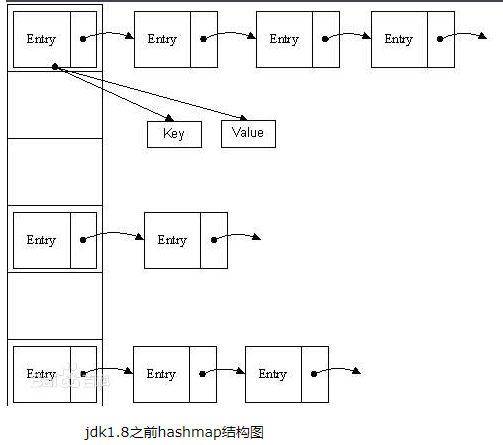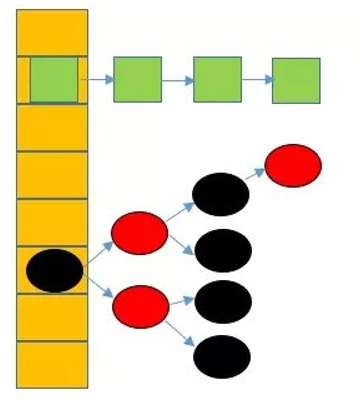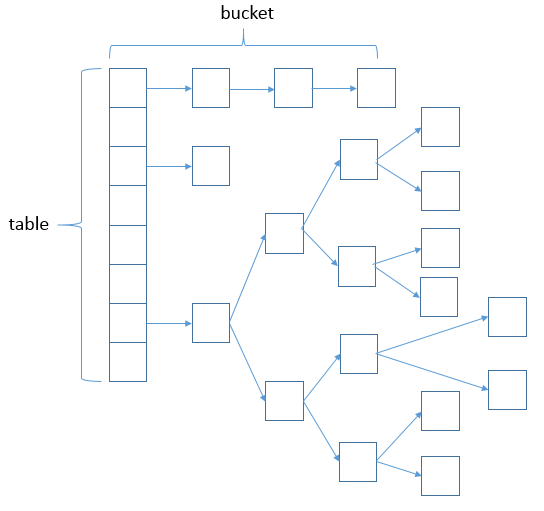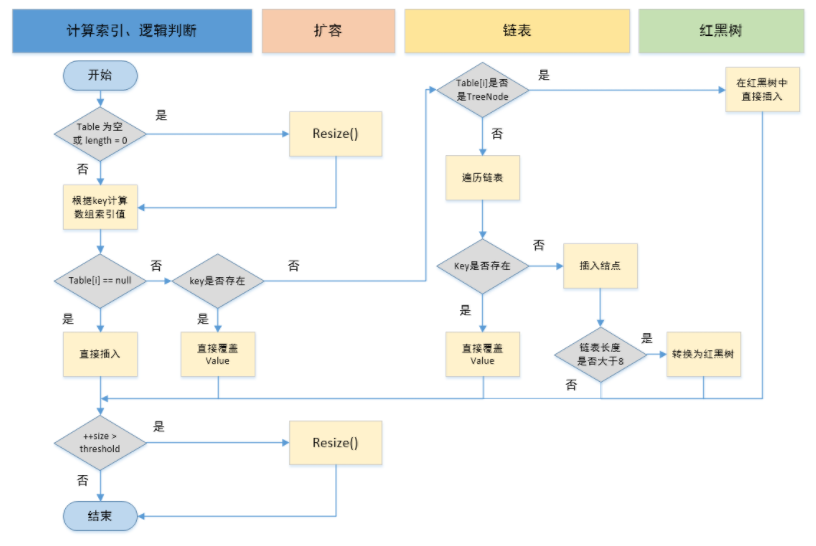走进JDK(十)------HashMap
有人说HashMap是jdk中最难的类,重要性不用多说了,敲过代码的应该都懂,那么一起啃下这个硬骨头吧!
一、哈希表
在了解HashMap之前,先看看啥是哈希表,首先回顾下数组以及链表
数组:采用一段连续的存储单元来存储数据。对于指定下标的查找,时间复杂度为O(1);通过给定值进行查找,需要遍历数组,逐一比对给定关键字和数组元素,时间复杂度为O(n),当然,对于有序数组,则可采用二分查找,插值查找,斐波那契查找等方式,可将查找复杂度提高为O(logn);对于一般的插入删除操作,涉及到数组元素的移动,其平均复杂度也为O(n)。
线性链表:对于链表的新增,删除等操作(在找到指定操作位置后),仅需处理结点间的引用即可,时间复杂度为O(1),而查找操作需要遍历链表逐一进行比对,复杂度为O(n)。
哈希表:相比上述几种数据结构,在哈希表中进行添加,删除,查找等操作,性能十分之高,不考虑哈希冲突的情况下,仅需一次定位即可完成,时间复杂度为O(1)。
数组查询快的一个主要原因就是每个元素都有对应的index,根据index可以很方便的取数,哈希表的主干则是使用数组结构。来个图:

当插入数据时,首先对要插入的数据进行哈希计算(哈希算法可以说直接影响哈希表性能),得到某个值,这个值也就是代表数据在哈希表中的存储位置。举个例子,当前哈希表的长度为6,那么对于任何的正整数%6,得到的结果肯定是0-5,这小学数学应该就懂了吧!然后将余数作为要插入的位置,进行数据的保存。那就会有人问了,如果不同数据插入时,计算得到的余数相同怎么办?非常好,这就是哈希冲突,或是哈希碰撞。
二、hash冲突(hash碰撞)
哈希冲突的解决方案有多种:开放定址法(发生冲突,继续寻找下一块未被占用的存储地址),再散列函数法,链地址法,而HashMap即是采用了链地址法,也就是数组+链表的方式。
对于HashMap来说,如果没有出现hash冲突,自然是最好的,找到对应位置直接插入即可;若是存在hash冲突,由于每个位置上存在的其实是链表,往当前链表上加数据。
在jdk1.8之前,hashmap图示如下:

在1.8中,如图:


bucket代表的是桶,也就是当某一个位置上面的节点数大于8时,采用红黑树,否则使用链表。
jdk1.8之前的hashmap都采用上图的结构,都是基于一个数组和多个单链表,hash值冲突的时候,就将对应节点以链表的形式存储。如果在一个链表中查找其中一个节点时,将会花费O(n)的查找时间,会有很大的性能损失。到了jdk1.8,当同一个hash值的节点数不小于8时,不再采用单链表形式存储,而是采用红黑树。
三、类定义、成员变量、构造函数
1、类定义
public class HashMap<K,V> extends AbstractMap<K,V> implements Map<K,V>, Cloneable, Serializable
2、成员变量
private static final long serialVersionUID = 362498820763181265L;
//初始化容量。左位移4位,也就是2的四次方
static final int DEFAULT_INITIAL_CAPACITY = 1 << 4; // aka 16
//最大容量
static final int MAXIMUM_CAPACITY = 1 << 30;
//加载因子
static final float DEFAULT_LOAD_FACTOR = 0.75f;
//当桶(bucket)上的结点数大于这个值时会转成红黑树
static final int TREEIFY_THRESHOLD = 8;
//当桶(bucket)上的结点数小于这个值时树转链表
static final int UNTREEIFY_THRESHOLD = 6;
//桶中结构转化为红黑树对应的table的最小大小
static final int MIN_TREEIFY_CAPACITY = 64;
//存储元素的数组,总是2的幂次倍
transient Node<K,V>[] table;
//存在所有的entry
transient Set<Map.Entry<K,V>> entrySet;
//实际存储的键值对的个数,不等于数组的size
transient int size;
//修改次数
transient int modCount;
//临界值,当实际大小(容量*填充因子)超过临界值时,会进行扩容
int threshold;
//负载因子,代表了table的填充度有多少,默认是0.75
final float loadFactor;
3、构造函数
public HashMap(int initialCapacity, float loadFactor) {
if (initialCapacity < 0)
throw new IllegalArgumentException("Illegal initial capacity: " +
initialCapacity);
//容量不能大于hashMap允许的最大值,超过了不会报错,默认最大值
if (initialCapacity > MAXIMUM_CAPACITY)
initialCapacity = MAXIMUM_CAPACITY;
//负载因子不能<=0,不能为非数字
if (loadFactor <= 0 || Float.isNaN(loadFactor))
throw new IllegalArgumentException("Illegal load factor: " +
loadFactor);
this.loadFactor = loadFactor;
//这个方法返回大于initialCapacity的最小的二次幂数值。
this.threshold = tableSizeFor(initialCapacity);
}
public HashMap(int initialCapacity) {
this(initialCapacity, DEFAULT_LOAD_FACTOR);
}
public HashMap() {
this.loadFactor = DEFAULT_LOAD_FACTOR; // all other fields defaulted
}
public HashMap(Map<? extends K, ? extends V> m) {
this.loadFactor = DEFAULT_LOAD_FACTOR;
//将m的所有元素存入本HashMap实例中。
putMapEntries(m, false);
}
四、内部类
1、Node
static class Node<K,V> implements Map.Entry<K,V> {
final int hash;
final K key;
V value;
Node<K,V> next;
Node(int hash, K key, V value, Node<K,V> next) {
this.hash = hash;
this.key = key;
this.value = value;
this.next = next;
}
public final K getKey() { return key; }
public final V getValue() { return value; }
public final String toString() { return key + "=" + value; }
public final int hashCode() {
return Objects.hashCode(key) ^ Objects.hashCode(value);
}
public final V setValue(V newValue) {
V oldValue = value;
value = newValue;
return oldValue;
}
public final boolean equals(Object o) {
if (o == this)
return true;
if (o instanceof Map.Entry) {
Map.Entry<?,?> e = (Map.Entry<?,?>)o;
if (Objects.equals(key, e.getKey()) &&
Objects.equals(value, e.getValue()))
return true;
}
return false;
}
}
2、keySet
final class KeySet extends AbstractSet<K> {
public final int size() { return size; }
public final void clear() { HashMap.this.clear(); }
public final Iterator<K> iterator() { return new KeyIterator(); }
public final boolean contains(Object o) { return containsKey(o); }
public final boolean remove(Object key) {
return removeNode(hash(key), key, null, false, true) != null;
}
public final Spliterator<K> spliterator() {
return new KeySpliterator<>(HashMap.this, 0, -1, 0, 0);
}
public final void forEach(Consumer<? super K> action) {
Node<K,V>[] tab;
if (action == null)
throw new NullPointerException();
if (size > 0 && (tab = table) != null) {
int mc = modCount;
for (int i = 0; i < tab.length; ++i) {
for (Node<K,V> e = tab[i]; e != null; e = e.next)
action.accept(e.key);
}
if (modCount != mc)
throw new ConcurrentModificationException();
}
}
}
3、Values
final class Values extends AbstractCollection<V> {
public final int size() { return size; }
public final void clear() { HashMap.this.clear(); }
public final Iterator<V> iterator() { return new ValueIterator(); }
public final boolean contains(Object o) { return containsValue(o); }
public final Spliterator<V> spliterator() {
return new ValueSpliterator<>(HashMap.this, 0, -1, 0, 0);
}
public final void forEach(Consumer<? super V> action) {
Node<K,V>[] tab;
if (action == null)
throw new NullPointerException();
if (size > 0 && (tab = table) != null) {
int mc = modCount;
for (int i = 0; i < tab.length; ++i) {
for (Node<K,V> e = tab[i]; e != null; e = e.next)
action.accept(e.value);
}
if (modCount != mc)
throw new ConcurrentModificationException();
}
}
}
4、entrySet
final class EntrySet extends AbstractSet<Map.Entry<K,V>> {
public final int size() { return size; }
public final void clear() { HashMap.this.clear(); }
public final Iterator<Map.Entry<K,V>> iterator() {
return new EntryIterator();
}
public final boolean contains(Object o) {
if (!(o instanceof Map.Entry))
return false;
Map.Entry<?,?> e = (Map.Entry<?,?>) o;
Object key = e.getKey();
Node<K,V> candidate = getNode(hash(key), key);
return candidate != null && candidate.equals(e);
}
public final boolean remove(Object o) {
if (o instanceof Map.Entry) {
Map.Entry<?,?> e = (Map.Entry<?,?>) o;
Object key = e.getKey();
Object value = e.getValue();
return removeNode(hash(key), key, value, true, true) != null;
}
return false;
}
public final Spliterator<Map.Entry<K,V>> spliterator() {
return new EntrySpliterator<>(HashMap.this, 0, -1, 0, 0);
}
public final void forEach(Consumer<? super Map.Entry<K,V>> action) {
Node<K,V>[] tab;
if (action == null)
throw new NullPointerException();
if (size > 0 && (tab = table) != null) {
int mc = modCount;
for (int i = 0; i < tab.length; ++i) {
for (Node<K,V> e = tab[i]; e != null; e = e.next)
action.accept(e);
}
if (modCount != mc)
throw new ConcurrentModificationException();
}
}
}
5、红黑树
//红黑树
static final class TreeNode<k,v> extends LinkedHashMap.Entry<k,v> {
TreeNode<k,v> parent; // 父节点
TreeNode<k,v> left; //左子树
TreeNode<k,v> right;//右子树
TreeNode<k,v> prev; // needed to unlink next upon deletion
boolean red; //颜色属性
TreeNode(int hash, K key, V val, Node<k,v> next) {
super(hash, key, val, next);
} //返回当前节点的根节点
final TreeNode<k,v> root() {
for (TreeNode<k,v> r = this, p;;) {
if ((p = r.parent) == null)
return r;
r = p;
}
}
}
红黑树比链表多了四个变量,parent父节点、left左节点、right右节点、prev上一个同级节点,红黑树内容较多,不在赘述。
五、主要方法
1、put()
//这个自然是用的最多的方法之一
public V put(K key, V value) {
return putVal(hash(key), key, value, false, true);
}
static final int hash(Object key) {
int h;
//如果key为null,hash值为0.不为null,获取key的hashcode(),然后将h无符号右位移16位,再与原来的h做异或运算。
//为啥这么弄?鬼知道。。。但是目的就是为了让散列均匀
return (key == null) ? 0 : (h = key.hashCode()) ^ (h >>> 16);
}
final V putVal(int hash, K key, V value, boolean onlyIfAbsent,
boolean evict) {
Node<K,V>[] tab; Node<K,V> p; int n, i;
//如果table为null或者长度为0,首先进行扩容。
if ((tab = table) == null || (n = tab.length) == 0)
n = (tab = resize()).length;
//(n-1)&hash是啥意思呢?目的:获取该对象的键在hashmap中的位置。n表示的是hash桶数组的长度,并且该长度为2的n次方,这样(n-1)&hash就等价于hash%n。因为&运算的效率高于%运算。(n-1)&hash=hash%n有一个前提,就是n为2的次方,比如2、4、8。。。
如果当前位置为null,说明还没有元素被放在这个位置,所以直接new一个node,放在此位置即可。
if ((p = tab[i = (n - 1) & hash]) == null)
//newNode就是new一个node,放入到当前数组的对应位置上。
tab[i] = newNode(hash, key, value, null);
else {
Node<K,V> e; K k;
//当前位置已经有node了,也就是出现了hash冲突
//如果桶中的第一个元素(数组中的结点)的hash值相等,key相等。
if (p.hash == hash &&
//判断Key是否与当前存在的node的key值相等
((k = p.key) == key || (key != null && key.equals(k))))
e = p;
//判断该链是红黑树
else if (p instanceof TreeNode)
//放入红黑树中
e = ((TreeNode<K,V>)p).putTreeVal(this, tab, hash, key, value);
//不是红黑树,肯定就是链表了
else {
//在链表的最末端插入节点
for (int binCount = 0; ; ++binCount) {
//如果当前node的next为null,说明当前的节点就是链表的最后一个元素
if ((e = p.next) == null) {
p.next = newNode(hash, key, value, null);
//因为bidCount从0开始,所以判断的值为TREEIFY_THRESHOLD - 1,大于TREEIFY_THRESHOLD,转换成红黑树
if (binCount >= TREEIFY_THRESHOLD - 1) // -1 for 1st
treeifyBin(tab, hash);
break;
}
//判断链表中结点的key值与插入的元素的key值是否相等。如果有相等的直接跳出循环
if (e.hash == hash &&
((k = e.key) == key || (key != null && key.equals(k))))
break;
p = e;
}
}
//表示在桶中找到key值、hash值与插入元素相等的结点
if (e != null) { // existing mapping for key
V oldValue = e.value;
if (!onlyIfAbsent || oldValue == null)
e.value = value;
afterNodeAccess(e);
return oldValue;
}
}
++modCount;
if (++size > threshold)
resize();
afterNodeInsertion(evict);
return null;
}
总结下putVal(),如下:

- ①.判断键值对数组table[i]是否为空或为null,否则执行resize()进行扩容;
- ②.根据键值key计算hash值得到插入的数组索引i,如果table[i]==null,直接新建节点添加,转向⑥,如果table[i]不为空,转向③;
- ③.判断table[i]的首个元素是否和key一样,如果相同直接覆盖value,否则转向④,这里的相同指的是hashCode以及equals;
- ④.判断table[i] 是否为treeNode,即table[i] 是否是红黑树,如果是红黑树,则直接在树中插入键值对,否则转向⑤;
- ⑤.遍历table[i],判断链表长度是否大于8,大于8的话把链表转换为红黑树,在红黑树中执行插入操作,否则进行链表的插入操作;遍历过程中若发现key已经存在直接覆盖value即可;
- ⑥.插入成功后,判断实际存在的键值对数量size是否超多了最大容量threshold,如果超过,进行扩容。
HashMap的数据存储实现原理
流程:
1. 根据key计算得到key.hash = (h = k.hashCode()) ^ (h >>> 16);
2. 根据key.hash计算得到桶数组的索引index = key.hash & (table.length - 1),这样就找到该key的存放位置了:
- ① 如果该位置没有数据,用该数据新生成一个节点保存新数据,返回null;
- ② 如果该位置有数据是一个红黑树,那么执行相应的插入 / 更新操作;
- ③ 如果该位置有数据是一个链表,分两种情况一是该链表没有这个节点,另一个是该链表上有这个节点,注意这里判断的依据是key.hash是否一样:
如果该链表没有这个节点,那么采用尾插法新增节点保存新数据,返回null;如果该链表已经有这个节点了,那么找到该节点并更新新数据,返回老数据。
注意:
HashMap的put会返回key的上一次保存的数据,比如:
HashMap<String, String> map = new HashMap<String, String>();
System.out.println(map.put("a", "A")); // 打印null
System.out.println(map.put("a", "AA")); // 打印A
System.out.println(map.put("a", "AB")); // 打印AA
2、get()
//get(key)方法的本质就是根据key值获取到对应的节点,然后将Node的value返回
public V get(Object key) {
Node<K,V> e;
return (e = getNode(hash(key), key)) == null ? null : e.value;
}
final Node<K,V> getNode(int hash, Object key) {
Node<K,V>[] tab; Node<K,V> first, e; int n; K k;
if ((tab = table) != null && (n = tab.length) > 0 &&
//在hashMap里,(n - 1) & hash = hash % n。证明方法:https://blog.csdn.net/evilcry2012/article/details/88823910
(first = tab[(n - 1) & hash]) != null) {
if (first.hash == hash && // always check first node
((k = first.key) == key || (key != null && key.equals(k))))
return first;
//链中的第一个节点不符合规定,继续往下找。
if ((e = first.next) != null) {
//如果是红黑树的话,查询红黑树的节点,然后返回。红黑树由于本人还不是非常清楚,所以暂不做解释了
if (first instanceof TreeNode)
return ((TreeNode<K,V>)first).getTreeNode(hash, key);
do {
//这时候就确定为链表结构的数据了,轻车熟路,不多解释了。不清楚的可以看看本人的LinkedList
if (e.hash == hash &&
((k = e.key) == key || (key != null && key.equals(k))))
return e;
} while ((e = e.next) != null);
}
}
return null;
}
3 、remove()
// HashMap 中实现
public V remove(Object key) {
Node<K,V> e;
return (e = removeNode(hash(key), key, null, false, true)) == null ?
null : e.value;
} // HashMap 中实现
final Node<K,V> removeNode(int hash, Object key, Object value,
boolean matchValue, boolean movable) {
Node<K,V>[] tab; Node<K,V> p; int n, index;
if ((tab = table) != null && (n = tab.length) > 0 &&
(p = tab[index = (n - 1) & hash]) != null) {
Node<K,V> node = null, e; K k; V v;
if (p.hash == hash &&
((k = p.key) == key || (key != null && key.equals(k))))
node = p;
else if ((e = p.next) != null) {
if (p instanceof TreeNode) {...}
else {
// 遍历单链表,寻找要删除的节点,并赋值给 node 变量
do {
if (e.hash == hash &&
((k = e.key) == key ||
(key != null && key.equals(k)))) {
node = e;
break;
}
p = e;
} while ((e = e.next) != null);
}
}
if (node != null && (!matchValue || (v = node.value) == value ||
(value != null && value.equals(v)))) {
if (node instanceof TreeNode) {...}
// 将要删除的节点从单链表中移除
else if (node == p)
tab[index] = node.next;
else
p.next = node.next;
++modCount;
--size;
afterNodeRemoval(node); // 调用删除回调方法进行后续操作
return node;
}
}
return null;
}
void afterNodeRemoval(Node<K,V> p) { }
4、 resize()
- ①.在jdk1.8中,resize方法是在hashmap中的键值对大于阀值时或者初始化时,就调用resize方法进行扩容;
- ②.每次扩展的时候,都是扩展2倍;
- ③.扩展后Node对象的位置要么在原位置,要么移动到原偏移量两倍的位置。
HashMap扩容可以分为三种情况:
第一种:使用默认构造方法初始化HashMap。从前文可以知道HashMap在一开始初始化的时候会返回一个空的table,并且thershold为0。因此第一次扩容的容量为默认值DEFAULT_INITIAL_CAPACITY也就是16。同时threshold = DEFAULT_INITIAL_CAPACITY * DEFAULT_LOAD_FACTOR = 12。
第二种:指定初始容量的构造方法初始化HashMap。那么从下面源码可以看到初始容量会等于threshold,接着threshold = 当前的容量(threshold) * DEFAULT_LOAD_FACTOR。
第三种:HashMap不是第一次扩容。如果HashMap已经扩容过的话,那么每次table的容量以及threshold量为原有的两倍。
/**
* Initializes or doubles table size. If null, allocates in
* accord with initial capacity target held in field threshold.
* Otherwise, because we are using power-of-two expansion, the
* elements from each bin must either stay at same index, or move
* with a power of two offset in the new table.
* @return the table
*
*
*
* 初始化或者翻倍表大小。
* 如果表为null,则根据存放在threshold变量中的初始化capacity的值来分配table内存
* (这个注释说的很清楚,在实例化HashMap时,capacity其实是存放在了成员变量threshold中,
* 注意,HashMap中没有capacity这个成员变量)
* 。如果表不为null,由于我们使用2的幂来扩容,
* 则每个bin元素要么还是在原来的bucket中,要么在2的幂中
*
* 此方法功能:初始化或扩容
*/
final Node<K,V>[] resize() {
Node<K,V>[] oldTab = table;
int oldCap = (oldTab == null) ? 0 : oldTab.length;
int oldThr = threshold;
//新的容量值,新的扩容阀界值
int newCap, newThr = 0;
//oldTab!=null,则oldCap>0
if (oldCap > 0) {
//如果此时oldCap>=MAXIMUM_CAPACITY(1 << 30),表示已经到了最大容量,这时还要往map中放数据,则阈值设置为整数的最大值 Integer.MAX_VALUE,直接返回这个oldTab的内存地址。
if (oldCap >= MAXIMUM_CAPACITY) {
threshold = Integer.MAX_VALUE;
return oldTab;
}
//如果(当前容量*2<最大容量&&当前容量>=默认初始化容量(16))
//并将将原容量值<<1(相当于*2)赋值给 newCap
else if ((newCap = oldCap << 1) < MAXIMUM_CAPACITY &&
oldCap >= DEFAULT_INITIAL_CAPACITY)
//如果能进来证明此map是扩容而不是初始化
//操作:将原扩容阀界值<<1(相当于*2)赋值给 newThr
newThr = oldThr << 1; // double threshold
}
else if (oldThr > 0) // initial capacity was placed in threshold
//进入此if证明创建map时用的带参构造:public HashMap(int initialCapacity)或 public HashMap(int initialCapacity, float loadFactor)
//注:带参的构造中initialCapacity(初始容量值)不管是输入几都会通过 “this.threshold = tableSizeFor(initialCapacity);”此方法计算出接近initialCapacity参数的2^n来作为初始化容量(初始化容量==oldThr)
newCap = oldThr;
else { // zero initial threshold signifies using defaults
//进入此if证明创建map时用的无参构造:
//然后将参数newCap(新的容量)、newThr(新的扩容阀界值)进行初始化
newCap = DEFAULT_INITIAL_CAPACITY;
newThr = (int)(DEFAULT_LOAD_FACTOR * DEFAULT_INITIAL_CAPACITY);
}
if (newThr == 0) { //进入此if有两种可能
// 第一种:进入此“if (oldCap > 0)”中且不满足该if中的两个if
// 第二种:进入这个“else if (oldThr > 0)” //分析:进入此if证明该map在创建时用的带参构造,如果是第一种情况就说明是进行扩容且oldCap(旧容量)小于16,如果是第二种说明是第一次put
float ft = (float)newCap * loadFactor;
//计算扩容阀界值
newThr = (newCap < MAXIMUM_CAPACITY && ft < (float)MAXIMUM_CAPACITY ?
(int)ft : Integer.MAX_VALUE);
}
threshold = newThr;
@SuppressWarnings({"rawtypes","unchecked"})
Node<K,V>[] newTab = (Node<K,V>[])new Node[newCap];
table = newTab;
//如果“oldTab != null”说明是扩容,否则直接返回newTab
if (oldTab != null) {
for (int j = 0; j < oldCap; ++j) {
Node<K,V> e;
if ((e = oldTab[j]) != null) {
oldTab[j] = null; if (e.next == null)
newTab[e.hash & (newCap - 1)] = e;
else if (e instanceof TreeNode)
//如果该元素是TreeNode的实例
((TreeNode<K,V>)e).split(this, newTab, j, oldCap);
else { // preserve order
Node<K,V> loHead = null, loTail = null;//此对象接收会放在原来位置
Node<K,V> hiHead = null, hiTail = null;//此对象接收会放在“j + oldCap”(当前位置索引+原容量的值)
Node<K,V> next;
do {
next = e.next;
//以下是扩容操作的核心,详情见我的博客:https://www.cnblogs.com/shianliang/p/9204942.html
if ((e.hash & oldCap) == 0) { if (loTail == null)
loHead = e;
else
loTail.next = e;
loTail = e;
}
else {
if (hiTail == null)
hiHead = e;
else
hiTail.next = e;
hiTail = e;
}
} while ((e = next) != null);
if (loTail != null) {
loTail.next = null;
newTab[j] = loHead;
}
if (hiTail != null) {
hiTail.next = null;
newTab[j + oldCap] = hiHead;
}
}
}
}
}
return newTab;
}
六、思考点
1、为啥HashMap的初始大小为16?并且每次自动扩展或是手动初始化,长度必须为2的幂?
用16当做初始化的数,主要是考虑到key映射到index的hash算法。例如index = Hash("apple"),hash运算要尽量分布均匀,最理想的效果就是在一个hashMap对象put操作时,永远不要有hash冲突,当然一般实现不了。有一种最简单hash运算就是拿hash%length,余数为0~length-1,这种方式可以实现,但是需要把十进制的数转成二进制,效率相对较慢。在jdk8中,jdk大神是这么干的,index = HashCode(Key)&(Length - 1),具体的原因可以看这篇博客:https://blog.csdn.net/evilcry2012/article/details/88823910
2、高并发环境,hashMap可能会出现死锁
可以看下这篇文章:高并发下的HashMap
走进JDK(十)------HashMap的更多相关文章
- 走进JDK(十二)------TreeMap
一.类定义 TreeMap的类结构: public class TreeMap<K,V> extends AbstractMap<K,V> implements Navigab ...
- 调试过程中发现按f5无法走进jdk源码
debug 模式 ,在fis=new FileInputStream(file); 行打断点 调试过程中发现按f5无法走进jdk源码 package com.lzl.spring.test; impo ...
- java多线程:并发包中ConcurrentHashMap和jdk的HashMap的对比
一:HashMap--->底层存储的是Entry<K,V>[]数组--->Entry<K,V>的结构是一个单向的链表static class Entry<K, ...
- Java进阶知识点:不要只会写synchronized - JDK十大并发编程组件总结
一.背景 提到Java中的并发编程,首先想到的便是使用synchronized代码块,保证代码块在并发环境下有序执行,从而避免冲突.如果涉及多线程间通信,可以再在synchronized代码块中使用w ...
- Java进阶知识点7:不要只会写synchronized - JDK十大并发编程组件总结
一.背景 提到Java中的并发编程,首先想到的便是使用synchronized代码块,保证代码块在并发环境下有序执行,从而避免冲突.如果涉及多线程间通信,可以再在synchronized代码块中使用w ...
- java jdk 中HashMap的源码解读
HashMap是我们在日常写代码时最常用到的一个数据结构,它为我们提供key-value形式的数据存储.同时,它的查询,插入效率都非常高. 在之前的排序算法总结里面里,我大致学习了HashMap的实现 ...
- jdk 8 HashMap源码解读
转自:https://www.cnblogs.com/little-fly/p/7344285.html 在原来的作者的基础上,增加了本人对源代码的一些解读. 如有侵权,请联系本人 这几天学习了Has ...
- 走进JDK(十一)------LinkedHashMap
概述LinkedHashMap 继承自 HashMap,在 HashMap 基础上,通过维护一条双向链表,解决了 HashMap 不能随时保持遍历顺序和插入顺序一致的问题.除此之外,LinkedHas ...
- 走进JDK(二)------String
本文基于java8. 基本概念: Jvm 内存中 String 的表示是采用 unicode 编码 UTF-8 是 Unicode 的实现方式之一 一.String定义 public final cl ...
随机推荐
- 经典笔试题型----IT经理(IT Manager)
一般企业设置IT部门都是服务性质,虽然谈IT需要成为战略部门许多年,但用脑子想下,这概率有多少?企业存在的第一目标是:赚取利润.贸易型企业最重要的部门为销售部,生产型企业最重要的部门为销售部与生产部, ...
- CentOS7 安装kafka集群
1. 环境准备 JDK1.8 ZooKeeper集群(参见本人博文) Scala2.12(如果需要做scala开发的话,安装方法参见本人博文) 本次安装的kafka和zookeeper集群在同一套物理 ...
- postgresql分区(引用)
1 建立大表. 2 创建分区继承 3 定义Rule或者Trigger? 1 建立大表 CREATE TABLE student (student_id bigserial, na ...
- 使用IntelliJ IDEA创建简单的Dubbo实例
这个博客是在https://blog.csdn.net/Crazer_cy/article/details/80397649篇文章上的基础上,自己学习用的. Zookeeper为dubbo的注册中心, ...
- Hash和HashCode深入理解
目录介绍1.Hash的作用介绍1.1 Hash的定义1.2 Hash函数特性1.3 Hash的使用场景2.如何判断两个对象相等2.1 判断两个字符串2.2 判断两个int数值2.3 其他基本类型3.H ...
- 学习excel的使用技巧四显示正常的数字
记得之前在excel中输入一些数字比如输入手机号 就会变成1.E几类似这种 那么怎样显示正常的数字呢 先选中要操作的输入框 1 找到 数字 这个功能的地方 2 设置为 数值 并且小数点为0 3 ...
- python TKinter部分记录
http://blog.shouji-zhushou.com/python-gui-tkinter-grid%E7%BD%91%E6%A0%BC%E5%87%A0%E4%BD%95%E5%B8%83% ...
- JAVA 没有重载运算符,那么 String 类型的加法是怎么实现的,以及String类型不可变的原因和好处
1, JAVA 不具备 C++ 和 C# 一样的重载运算符 来实现类与类之间相互计算 的功能 这其实一定程度上让编程失去了代码的灵活性, 但是个人认为,这在一定程度上减少了代码异常的概率 ...
- 深度学习原理与框架-递归神经网络-RNN_exmaple(代码) 1.rnn.BasicLSTMCell(构造基本网络) 2.tf.nn.dynamic_rnn(执行rnn网络) 3.tf.expand_dim(增加输入数据的维度) 4.tf.tile(在某个维度上按照倍数进行平铺迭代) 5.tf.squeeze(去除维度上为1的维度)
1. rnn.BasicLSTMCell(num_hidden) # 构造单层的lstm网络结构 参数说明:num_hidden表示隐藏层的个数 2.tf.nn.dynamic_rnn(cell, ...
- JAVA算术运算符
算术运算符 +.-.*(乘号)./(除号,取商).%(取余数.取模) 特殊的运算符:++(加加).--(减减) int a = 1; a+=10; 等同于a=a+10; a-=5; 等同于a= ...
